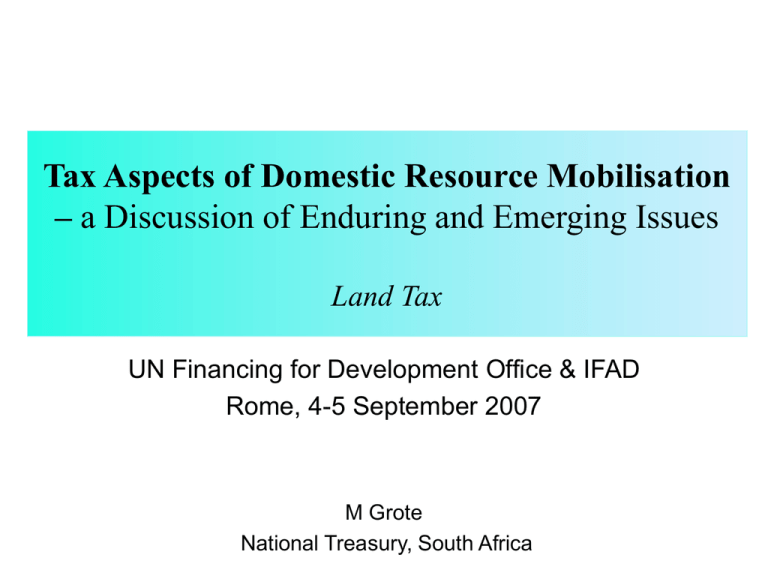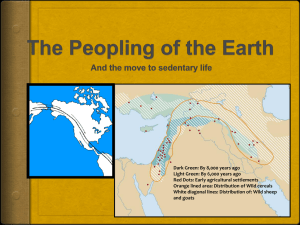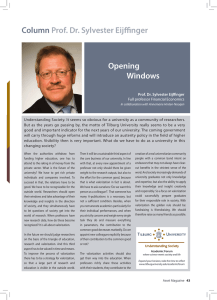Land Tax (Grote) - the United Nations
advertisement

Tax Aspects of Domestic Resource Mobilisation – a Discussion of Enduring and Emerging Issues Land Tax UN Financing for Development Office & IFAD Rome, 4-5 September 2007 M Grote National Treasury, South Africa Forms of property taxation • 3 basic form of property taxation: – Tax based on annual or rental value of property – (estimated net rental value pa) – Tax based on capital value of land & improvements – tax based on assessed valueo of land & improvements – Tax based on site or land value: • Kenya, Australia, New Zealand, (South Africa), Taiwan land value system is the site system, excluding improvements such as factory buildings or houses or crops – narrow tax base necessitating higher tax rates • Ad valorem property taxes target ownership of fixed real estate: – Based on assessed value or a closely related proxy • Agricultural land tax (value of unimproved land in its agricultural use) – – – – Not to disincentivise productive investments Value does not include improvements such as fencing, drainage, dams Opportunity costs Hence, market value of the freehold without encumbrances & improvements • Urban property tax or ‘rates’ or site value tax is on market value: – Flat rate tax would tax value of building & land (total improved land) – Value of land & fixed investments/improvements – In urban context market value readily observable, determined by valuers based on active property market – close comparables (recently traded properties) Economic theory & rationale for land tax • Arguments in favour of land tax (see H George, John Locke): – To provide for own-source revenues for local governments & land reform • Beneficial land market effects: lower entry price, stop under-utilisation of prod. land – Land taxes should not distort economic incentives (fixed supply of land) – Equitable, as it targets unearned income: Value capture – rent caused by public investment or inherent potential of land without investment/activity of landowner (benefit received principle) • Is progressive as owners of large properties must pay more (=ability to pay principle) • Automatically compensates for land value changes – if land value improves because of public infrastructure projects, value & tax increase commensurately • Addresses “free-rider” problem • Public sector may invest even more, thereby improving agricultural outlook • Targeting unimproved land may lead to productivity-enhancing investments – Disincentive to land speculation in both urban & rural areas – Assist in breaking up large farm units with accompanying increases in production – intensified land use (see Chile land reforms) – Relatively easy to administer (cannot hide land) – improves tax morale • Arguments against: – Local governments must rely on more than one tax – Valuation & admin could be challenging for low income countries – Land tax may intensify intensive land use with adverse impact on environment Administrative systems • Valuation methods: – Area based land tax: measured land area adjusted by fertility of soil & location – Self-appraisal: taxpayer provides value assessment but under-valuation arrested with expropriation clause whereby govt. buys land @ declared value – Computer Aided Mass Appraisal: en masse valuations by relying on key statistical coefficients (both used in rural & urban areas) – Banding: assess properties according to 1 to 7 value bands in lieu of individual valuations • Collection should be done at local level: – Globally, taxation most efficient when tax collection & expenditure of these revenues executed by same level of government (subsidiarity/Tiebout principle) – Tax rate be set by local government (effective collection in SA already at 0.5%) – At this rate land tax capitalisation (=neg. impact on land values) will be low (in case of SA at 1% of land tax rate, land values will decline by 5%) – Communal areas without freehold rights should be exempted / fair assignment of shares – Tax relief for poorest cohorts: sufficiently high thresholds (admin expediency, phasing-in to improve acceptability BUT not for low agricultural produce prices) – Special relief measures or tax credits in times of drought / catastrophic events Other design issues or tax alternatives • Value of uniform and up-to-date cadastre: – Choice of tax base for valuation informed by availability / verifiability of data – In cities choice between rental value, capital value, land value, market value – In rural areas: determined by land use potential (climatic regions, soil types, potential for crops’ multi-year cash flow potential) • International practices & justification for land taxes (World Bank, 2006): – – – – – – – – – Promoting urban renewal Ensuring productive use of restituted land Defining property rights – against which emerging farmers can borrow Creating land valuation capacity (needed for Capital Gains Tax) Ease in structural / redistributional reforms Saving on assessment costs Discouraging foreign absentee ownership Arresting excessive speculation Managing political pressures regarding unequal access / ownership of land • Policy question: revenue potential doubtful in Africa, given subsistence farming? – Land taxes generate up to 7% of total revenue in industrialized economies Current SA land redistribution reforms • SA Government seeks to accelerate land reform program – progressive land taxes are one of instruments (next to distributing govt.-owned land) • Possibly extending property taxes as provided in Municipal Property Rates Act (MPRA) of 2004 to agricultural land – BUT relief for improvements • 2 options investigated: – Agricultural land tax conforming to requirements of MPRA – fast-tracking reform – Drafting new law specific to agricultural land, assigning tax collections to local authorities (service delivery) or national government (land redistribution finance) • According to MPRA total land surface of SA distributed across 237 local & metropolitan municipalities with mandate to levy property rates, however, only few collect currently from commercial farms – MPRA applicable to agri-land, taxing also improvement in support of simplicity? • Pre-1994 many municipalities did exempt agricultural land, other used regressive charging: first ha was taxed 100X more than 20th ha • Central govt. will impose uniform standards and cap annual rate increases • Currently, difficult discussion as to exempting certain lands or properties owned by govt.: dams, nature conservation sites, servitudes for power lines What about betterment/valorization taxes? • Betterment taxes / special assessment apportion cost of public infrastructure investment to property owners benefiting from improvements – Levied for narrowly targeted public investment and charges limited to property owners who directly benefit from it – E.g., irrigation systems, new roads, urban renewal projects • Special form of betterment tax is valorization tax has been successfully implemented in Columbia, Mexico to improve urban infrastructure but with active coordination, buy-in and public selection / prioritisation of projects (greening projects, street lighting, public libraries, sewers – Projects are compared as to benefits & costs, public mostly affected can make input and be consulted on execution of project – Deepening of democracy ought to be encouraged – In early 1960’s Columbia’s valorization tax contributed up to 38.6% of total property tax collections






